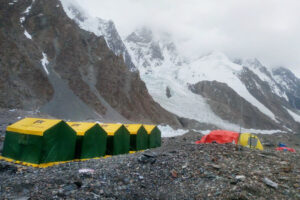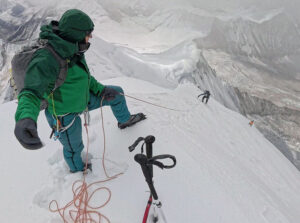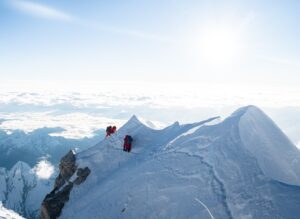The tragic death of Muhammad Hassan on K2 as dozens of climbers stepped over him on their way to the summit shocked climbers and non-climbers alike.
ExplorersWeb’s story, the first to be published on the subject, helped prompt the government of Gilgit-Baltistan to launch an inquiry. The inquiry attempted to get at the facts and make changes to prevent such incidents in the future. The results were published on September 8.
Though the 70-page report includes some details that contradict testimonies and photo evidence (such as the weather that night, which was not stormy, unlike the report’s statement) and leaves several unanswered questions, the long set of recommendations and changes marks a turning point.
A two-year ban
The government has banned Lela Peak Expeditions, the outfitter who hired Hassan, from managing teams in Gilgit-Baltistan for the next two years. The ban is for not providing a porter with adequate equipment, hiring an inexperienced porter to go up the mountain, and not insuring him.
This is a major blow for the Skardu-based company run by brothers Anwar and Akhbar Syed. All of Pakistan’s 8,000’ers lie within Gilgit-Baltistan. It is also a warning to other outfitters, both local and foreign. Lela Peak was contracted for logistical support by foreign companies, and these need to be equally careful to fulfill those same government requirements. With ever-increasing numbers of climbers on Pakistan’s highest peaks, the demand for support staff can be hard to find.
Video by Lakpa T. Sherpa:
The porters’ voice
“Perhaps it’s time to give the voice to the porters,” Yutta Vanessa Torkel of Norway wrote in a letter addressed to ExplorersWeb and other media. Torkel met Hassan and another porter (who was also on K2 this year but prefers to remain anonymous) during a trek to K2 Base Camp in 2017. He subsequently kept in touch with them.
“Neither of them had education or experience, it was learning by doing, or climbing, a predestined fatal approach,” Torkel said. “Until recently, they were both just non-specialized, low-altitude porters, earning around $55 for a three-week trek.”

Climbers pass the body of Muhammad Hassan. Frame from a video: Lakpa T Sherpa
During the 2017 trek, Torkel learned that porters rarely received gear. When they were, they sold it immediately. “This [sale] was worth so much that it made up for the miserable conditions without equipment,” she said.
During the summit push on K2 this summer, Hassan’s friend refused to go any further than Camp 3, but Hassan continued. After Hassan’s accident, his friend shared his frustrations with Torkel. “He [the friend] cannot do anything except be a HAP again next year when the bosses tell him to. He hates it. He doesn’t want to do it,” Torkel explained.

A large number of climbers at the traverse, in front of and behind a stricken Muhammad Hassan, circled. Photo: Philip Flaemig
Few porters can speak out
For that same reason, very few Pakistani porters are willing to speak out. Yousuf Meeri of Hushe village was a rare exception. He agreed to make some general remarks based on his wide experience.
“There are many problems with porters, starting with their poor equipment, which is essential for climbing,” he said. “Even worse, Pakistani climbers have very little technical skill because we don’t have any training centers here. Finally, there is a problem with insurance. If a porter dies at work, the family only gets two lakh rupees ($650).”
Fortunately for Yousuf, he is an experienced high-altitude porter and has good equipment after so many expeditions.

Yousuf Meeri on K2. Photo: Yousuf Meeri
Why was Hassan so high up?
That is the key question, according to Torkel. But the answer isn’t clear. Hassan was apparently not following orders.
Luis Miguel Soriano climbed K2 the day after Hassan’s death. He was a cameraman for climbers with Alex Abramov’s Seven Summit Club. It was Abramov who asked Lela Peak to provide three porters as his group’s contribution to the rope-fixing team.
“After carrying loads to Camp 3, our expedition leader [Abramov] ordered all Pakistani porters to return to Base Camp from Camp 3, without attempting the summit,” Soriano said. “All did so, except Hassan. According to his partners, [Hassan] decided to push further, against the others’ advice, saying that the summit was too close to let it go.”
Soriano believes that the summit would have provided prestige and higher income for Hassan, who needed money to provide for his three children and sick mother.
Regarding the accident, Soriano said:
“I believe that if a person’s life is in danger, everything necessary must be done to save them. But being realistic, the circumstances of the accident and the place where it happened caused Hassan’s death. Yes, a rescue should have been attempted, but nearly everyone around him at that moment lacked the physical strength or technical ability for something like that, and the Sherpa guides had the lives of their clients in their hands.”
Soriano agrees that it is essential to tackle the problem at the root, by improving conditions, equipment, and preparation of Pakistani staff on these high mountains.

K2 at night. Photo by Luis M. Soriano
A sherpa’s voice
The situation in Pakistan is not so different from that in Nepal a few decades ago. The sherpa climbers and guides have improved their conditions and skills substantially over the years.
UIAGM guide, expedition leader, and K2 winter summiter Mingma G emphasized that the problem is not with the porters but with their conditions.
“Pakistani climbers are very strong and they work hard,” Mingma G notes. “We see their hard work to Camp 1 and Camp 2. They go there with less equipment and they can’t bear the cold beyond that altitude, so they give up. This is because organizers charge less money from clients and pay less to their staff, so the staff can’t afford good equipment. They also depend on one season’s earnings for the whole year, so they try to save money and climb with limited equipment. All of this results in problems such as the failure of expeditions, frostbite, or even death.”

Mingma G at K2 Base Camp. Photo: Mingma G
The main issues
Mingma G lists some of the issues demanding urgent action:
1. Helicopter rescue is too costly. It costs over $20,000 for one trip. Some companies may not be willing to foot that bill. It is easier to declare the porter dead.
2. Insurance is too low or there is no insurance for porters at all. Policies coverage is very low, not only in the case of deaths, but also around evacuation, rescue, and medical expenses.
3. Most porters don’t have climbing training. They only have one season, and the families depend on the earnings from it for a whole year. Whatever they learn during the season, they forget before the next season. So many climbers don’t progress.
4. There is no good equipment because companies in Pakistan are all selling expeditions based on price competition, and they don’t give enough money to their staff in the field.

Sirbaz Khan with a sherpa from Mingma G’s Imagine Nepal team on the summit of Makalu. Photo: Sirbaz Khan
“If porters get proper equipment, training, and a daily allowance, they’ll become some of the best climbers and guides in the future. Physically, they are as strong as Nepalese sherpa,” Mingma G said.
Mingma G mentioned Ali Sadpara (who perished while attempting winter K2) and the late Ali Reza Sadpara as examples of world-class Pakistani climbers.
Plus, the next generation is on the way: “Sirbaz Khan, Sohail Sakhi, and Abdul Joshi are taking bridge courses in Nepal so that they can take IFMGA guide training,” Mingma G added.
Gabriel Tarso’s statements
The Gilgit-Baltistan inquiry document attached a detailed report of events by Gabriel Tarso of Brazil. Tarso worked as a cameraman with Kristin Harila of Norway during her record-pursuing summit push on K2.
Tarso describes how he tried his best to help Hassan and mentions that Tenjen Sherpa also helped. Hassan had fallen upside down while clipped to the ropes, his jacket rolled up to his neck in freezing temperatures. He remained like that, groaning in pain, for some time until Harila’s team approached.
While Tarso doesn’t mention Harila as actively helping in the rescue (as she described in her own account published on her website two weeks after the incident), he confirms that Tenjen Sherpa tried to pull the porter up, without success.
Eventually, Tenjen and Harila proceeded up “as they heard that the rope-fixing team was in trouble,” which is coherent with what Harila wrote in her report.

An excerpt from Gabriel Tarso’s written statement.
Tarso remained with Hassan until he noticed that he, Tarso, was running out of oxygen. He said that, despite the shock and lack of motivation, he had to go up because the sherpa who carrying an extra oxygen bottle for him was higher up, with Harila’s team.

An excerpt from Gabriel Tarso’s written statement.
The turning point
Tarso will receive an “appreciation letter” from the local Governor. The inquiry does not mention the large number of climbers who were at or near the site of the accident and literally jumped over Hassan on their way to the summit.
The document does include a reminder of the mandatory fulfillment of a list of “mountaineering rules and regulations” published in 1999. Some are rather vague, such as the petition to set “emergency protocols” including “shelters and rendezvous points” and a non-specified “rescue mechanism.”
But other elements from the inquiry could make a real impact: mandatory and better insurance policies for HAPs, a revision of regulations, a stronger role for Liaison Officers, and a system of fines and accountability for the expedition outfitters around planning and execution.
The impact of Hassan’s death
How (and if) these recommendations are implemented remains to be seen, but the story about Hassan’s tragic death has certainly impacted the climbing community.
We only found out the circumstances of Hassan’s death because of the courage of Wilhelm Steindl and Philip Flaemig. Members of the Furtenbach Adventures team, they turned around from the Bottleneck but refused to ignore what had happened further up the mountain. Without them, Hassan’s death may have only been a line at the end of some enthusiastic summit reports.

Headlamps mark the way up the Bottleneck in the early hours of July 27. Photo: Wilhelm Steindl
As a postscript, it is worth noting that the tragedy has led to some positive steps. The GoFundMe set up by Willi Steindl has raised over $170,000 so far. Other climbers, including Kristin Harila, have shared links to the fund.
Steindl told ExplorersWeb that he is overwhelmed by the response. He will return to Pakistan on September 15 to visit Hassan’s family, help with the fund’s management, and talk to authorities about building a climbing and training center for porters.

Wilhem Steindl (left) visited Muhammad Hassan’s family on his return from K2 last month and decided to start a fundraising campaign. Photo: Philip Flaemig






